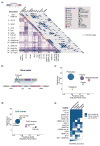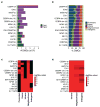Epigenetic Identity in AML Depends on Disruption of Nonpromoter Regulatory Elements and Is Affected by Antagonistic Effects of Mutations in Epigenetic Modifiers
- PMID: 28408400
- PMCID: PMC5540802
- DOI: 10.1158/2159-8290.CD-16-1032
Epigenetic Identity in AML Depends on Disruption of Nonpromoter Regulatory Elements and Is Affected by Antagonistic Effects of Mutations in Epigenetic Modifiers
Abstract
We performed cytosine methylation sequencing on genetically diverse patients with acute myeloid leukemia (AML) and found leukemic DNA methylation patterning is primarily driven by nonpromoter regulatory elements and CpG shores. Enhancers displayed stronger differential methylation than promoters, consisting predominantly of hypomethylation. AMLs with dominant hypermethylation featured greater epigenetic disruption of promoters, whereas those with dominant hypomethylation displayed greater disruption of distal and intronic regions. Mutations in IDH and DNMT3A had opposing and mutually exclusive effects on the epigenome. Notably, co-occurrence of both mutations resulted in epigenetic antagonism, with most CpGs affected by either mutation alone no longer affected in double-mutant AMLs. Importantly, this epigenetic antagonism precedes malignant transformation and can be observed in preleukemic LSK cells from Idh2R140Q or Dnmt3aR882H single-mutant and Idh2R140Q/Dnmt3aR882H double-mutant mice. Notably, IDH/DNMT3A double-mutant AMLs manifested upregulation of a RAS signaling signature and displayed unique sensitivity to MEK inhibition ex vivo as compared with AMLs with either single mutation.Significance: AML is biologically heterogeneous with subtypes characterized by specific genetic and epigenetic abnormalities. Comprehensive DNA methylation profiling revealed that differential methylation of nonpromoter regulatory elements is a driver of epigenetic identity, that gene mutations can be context-dependent, and that co-occurrence of mutations in epigenetic modifiers can result in epigenetic antagonism. Cancer Discov; 7(8); 868-83. ©2017 AACR.This article is highlighted in the In This Issue feature, p. 783.
©2017 American Association for Cancer Research.
Conflict of interest statement
Figures






References
-
- Bullinger L, Ehrich M, Dohner K, Schlenk RF, Dohner H, Nelson MR, et al. Quantitative DNA methylation predicts survival in adult acute myeloid leukemia. Blood. 2010;115:636–42. - PubMed
MeSH terms
Substances
Grants and funding
LinkOut - more resources
Full Text Sources
Other Literature Sources
Medical
Molecular Biology Databases
Miscellaneous

